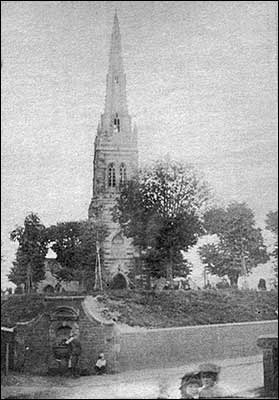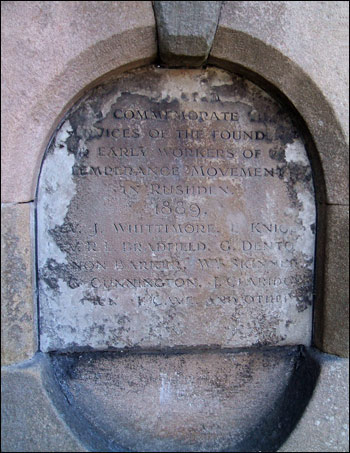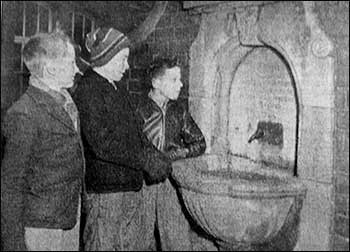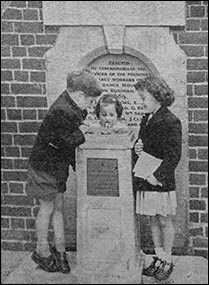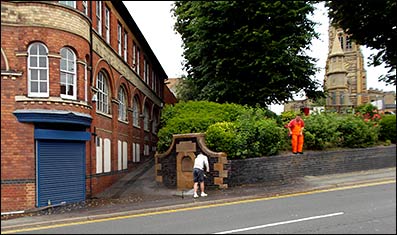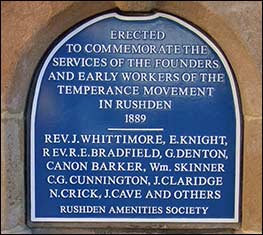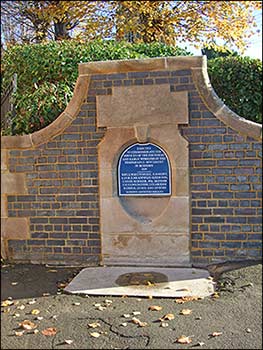Wellingborough & Kettering News 26/04/1889, transcribed by Peter Brown
OPENING OF A DRINKING FOUNTAIN AT RUSHDEN
The rise and progress of the parish of Rushden from a country village to a manufacturing town is largely due to the thrift and enterprise of several of the pioneers of the temperance movement, who have risen from the ranks to the position of manufacturers and large employers of labour. Amongst the departed fathers of Temperance in the village may be numbered Mr. Ebenezer Knight, Mr. John Sargent, Rev. R. Bradfield, Mr. W. Colson, and Mr. John Knight; while there remain at the present day Mr. John Cave, Mr. Chas. Bayes, Mr. Wm. Claridge, and Mr Jabez Colson. After the death of Mr. Ebenezer Knight three or four years ago it was suggested, at the annual meeting of the Rushden Temperance Society, that the members should take some steps to commemorate his life and work, and ultimately the idea was broadened so that the memorial should also embrace the other founders of the temperance movement in Rushden. After various suggestions had been made a drinking fountain was decided upon. It was first arranged that the site should be at the bottom of the hill against the Gas works and the permission of the Highway Board was obtained, but this site did not meet with unanimous approval. It was then agreed that the fountain should be placed on the Green, and the parish having obtained £40 by the sale of the pound, expended this sum on improvement of the Green, by building a new boundary wall and making a path leading from Mr. Woodward's to the Green. The wall was built of Staffordshire blue bricks and Mr. H A Cooper, architect, provided a design for a fountain in harmony with the wall, the same kind of bricks being used, with Derbyshire stone. This has now been placed at the corner of the Green nearest Mr. Claridge’s house, the work having been carried out by Mr. Dawkins, of Wellingborough. Just above the fountain is the following inscription:- “Erected to commemorate the services of the founders and early workers of the temperance movement in Rushden, 1889.” On the other side of the road is a drinking trough with a constant supply of water running into it, whilst it is contemplated putting a smaller receptacle for the canine species.
On Easter Monday afternoon the opening proceedings took place in the presence of three or four hundred spectators, amongst whom were the Rev. W. J. Tomkins, Rev. T. G. Harpur (Rushden), Mr. C. Pollard, Mr. F. Smith, Mr, J. Hutchen (Kettering), Mr. J. Cave, Mr. G. Denton, Mr. J. Claridge, Mr. J. Sargent, Mr. C. Bayes, and others. The Rushden Temperance Band having given a selection, Rev. W. J. Tomkins briefly introduced the various speakers, and humorously referred to a suggestion which had been made that the tap should be laid over from the "Wheat Sheaf." He stated that the cost of the fountain was £35, towards which £30 had already been subscribed.—Mr. C. Bayes, the treasurer, also added a few words, explaining that the Rushden Temperance Society was started in 1839, and that he became a member in 1841, and had been associated with the early workers in the movement. Mr. F. Smith (Kettering) next addressed the meeting, and spoke in feeling terms of the men whose memory they were met to honour.—Mr. Charles Pollard, Kettering, expressed the pleasure it gave him to be there to pay tribute the “honest workers" who founded the temperance movement in Rushden. Mr. J. Jenkinson, he said, was the first to bring temperance principles to Rushden from Kettering, and although it had been the means of doing so much good, they, at Kettering, were not any the poorer for it. The speaker concluded an earnest address by inviting all those who belonged to the “Lushington” family to sign the pledge and become workers in the cause of temperance – (Mr Pollard has kindly promised to contribute a sketch of the early temperance workers for insertion in our columns.) – Mr Hutchen, of Kettering, also addressed the meeting. – Votes of thanks to the friends from Kettering closed the proceedings. – The collection realised £2 4s. 6d.
The part of the proceedings being over an adjournment was made to the New Hall, when about 100 partook of tea provided by the manager and manageress.
Later on a public meeting was held when the building was crowded. Mr. J. Cave presided, and in his opening remarks dwelt on the work of the Society and its small beginning and the pleasure he felt in seeing such a large audience.
Rev. W. J. Tomkins, in the course of an interesting address, said that afternoon they had been looking back and thinking of the early workers in the temperance cause. They had erected a monument in the fountain, but that after all was not the best memorial, for the best monument to the work which had been done was found in the prosperity of the Temperance Society and Bands of Hope. But those whose work they specially commemorated that day were only a part of a noble band of workers scattered throughout the country; and it was his firm conviction that the world had never seen truer heroes than the pioneers of the temperance movement. (Cheers.) They were men of principle, who had minds of their own, and were convinced that strong drink was not essential to health or happiness, but was positively injurious. They were men of pluck, for it needed no small courage to advocate their principles when there was such strong prejudice against them, and when they were exposed to contumely and scorn. They were also men of prayer; they knew the strength of the foe with which they had to contend, and felt the need of wisdom and strength. They were men of perseverance, for they were not discouraged, but kept pegging away. In the present they wanted to catch their spirit, and their fire of enthusiasm. If they looked around he thought, they would find some encouragement in the reduction of the drink bill, in the recent division on Sunday closing, and in having a representative in the House of Commons in accord with their views. Still, there was great need for further effort, for the traffic was enormous, and the misery resulting from it appalling. There were opportunities for individual effort, and they should be on the look-out for them; and he trusted that in the future they would have better legislation.
Rev. T. G. Harpur was the next speaker, and in an able speech referred to the progress of the temperance reformation in the country. He then went on to speak of the scientific and medical aspects of the temperance question, and the social influence the movement now exerted over the country. As a minister of the gospel, he felt it right to set his face against any evils which existed, as he believed that that which was an enemy to man was an enemy to Christ. He also urged that those who had reaped advantages from total abstinence should be willing to make sacrifices on its behalf.
During the proceedings Mr. A. C. G. Vann, the head master of the National Schools, conducted a choir of about 80 children from his school, who sang a selection of songs in a very pleasing and creditable manner.
|
